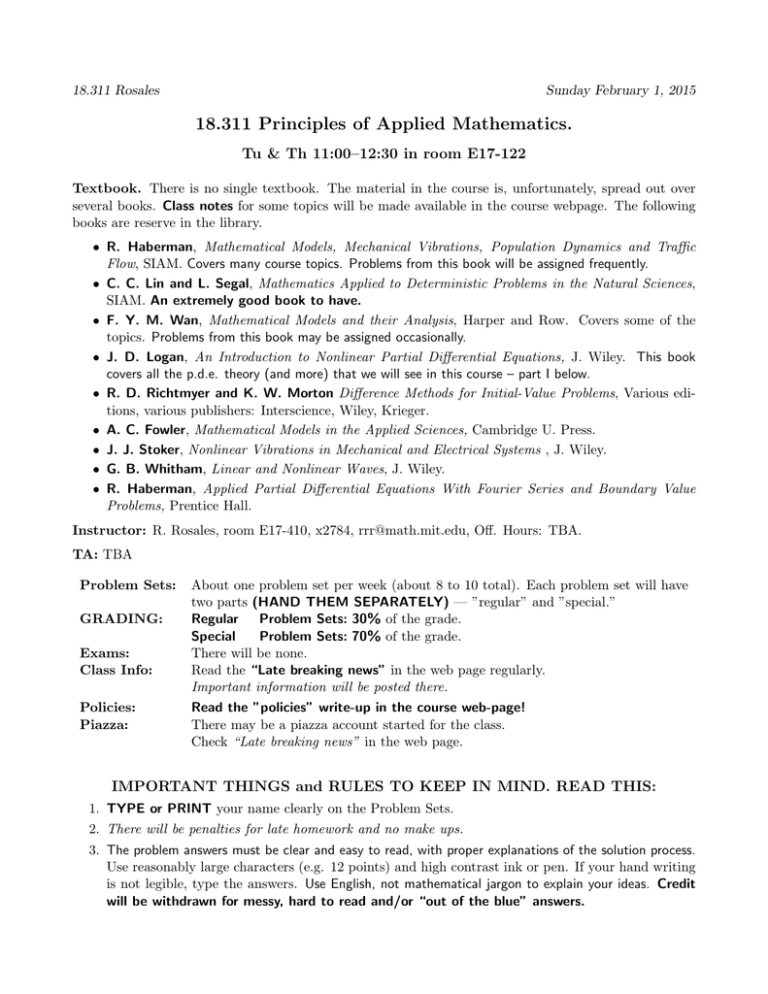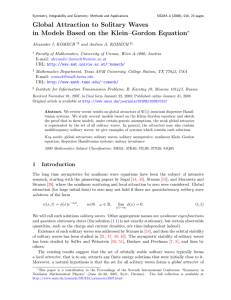18.311 Principles of Applied Mathematics.
advertisement

18.311 Rosales Sunday February 1, 2015 18.311 Principles of Applied Mathematics. Tu & Th 11:00–12:30 in room E17-122 Textbook. There is no single textbook. The material in the course is, unfortunately, spread out over several books. Class notes for some topics will be made available in the course webpage. The following books are reserve in the library. • R. Haberman, Mathematical Models, Mechanical Vibrations, Population Dynamics and Traffic Flow, SIAM. Covers many course topics. Problems from this book will be assigned frequently. • C. C. Lin and L. Segal, Mathematics Applied to Deterministic Problems in the Natural Sciences, SIAM. An extremely good book to have. • F. Y. M. Wan, Mathematical Models and their Analysis, Harper and Row. Covers some of the topics. Problems from this book may be assigned occasionally. • J. D. Logan, An Introduction to Nonlinear Partial Differential Equations, J. Wiley. This book covers all the p.d.e. theory (and more) that we will see in this course – part I below. • R. D. Richtmyer and K. W. Morton Difference Methods for Initial-Value Problems, Various editions, various publishers: Interscience, Wiley, Krieger. • A. C. Fowler, Mathematical Models in the Applied Sciences, Cambridge U. Press. • J. J. Stoker, Nonlinear Vibrations in Mechanical and Electrical Systems , J. Wiley. • G. B. Whitham, Linear and Nonlinear Waves, J. Wiley. • R. Haberman, Applied Partial Differential Equations With Fourier Series and Boundary Value Problems, Prentice Hall. Instructor: R. Rosales, room E17-410, x2784, rrr@math.mit.edu, Off. Hours: TBA. TA: TBA Problem Sets: GRADING: Exams: Class Info: Policies: Piazza: About one problem set per week (about 8 to 10 total). Each problem set will have two parts (HAND THEM SEPARATELY) — ”regular” and ”special.” Regular Problem Sets: 30% of the grade. Special Problem Sets: 70% of the grade. There will be none. Read the “Late breaking news” in the web page regularly. Important information will be posted there. Read the ”policies” write-up in the course web-page! There may be a piazza account started for the class. Check “Late breaking news” in the web page. IMPORTANT THINGS and RULES TO KEEP IN MIND. READ THIS: 1. TYPE or PRINT your name clearly on the Problem Sets. 2. There will be penalties for late homework and no make ups. 3. The problem answers must be clear and easy to read, with proper explanations of the solution process. Use reasonably large characters (e.g. 12 points) and high contrast ink or pen. If your hand writing is not legible, type the answers. Use English, not mathematical jargon to explain your ideas. Credit will be withdrawn for messy, hard to read and/or “out of the blue” answers. 4. Talk to me if you have a problem! Don’t wait till it becomes unsolvable. 5. If you do not understand something in class: STOP ME AND ASK for a better explanation, please! OUTLINE of the 18.311 LECTURES. A rough idea of the topics to be covered follows. Some topics may be covered in more detail than this suggests, or the reverse. Some topics may be skipped completely and others may be included if needed. This is just to give you an idea of the flavor of the course. PART I. Some basic topics in Nonlinear Waves. • Shock waves and hydraulic jumps. Description and various physical set ups where they occur: traffic flow, shallow water. What is a wave. • Fundamental concepts in continuous applied mathematics. Continuum limit. Conservation laws, quasi-equilibrium. Kinematic waves. • Traffic flow (TF). Continuum hypothesis. Conservation and derivation of the mathematical model. Integral and differential forms. Other examples of systems where conservation is used to derive the model equations (in nonlinear elasticity, fluids, etc.) • Linearization of equations of TF and solution. Meaning and interpretation. Solution of the fully nonlinear TF problem. Method of characteristics, graphical interpretation of the solution, wave breaking. Weak discontinuities, shock waves and rarefaction fans. Envelope of characteristics. Irreversibility in the model. • Quasilinear First Order PDE’s. • Shock structure, diffusivity. Burger’s equation. The Cole-Hopf transformation. The heat equation: derivation, solution, and application to the Burger’s equation. Inviscid limit and Laplace’s method. • Dimensional analysis. Nonlinear diffusion and fronts. PART II. Numerical solutions, series, and transforms. • Numerical solution of wave equations. Finite differences. Good and bad numerical schemes: consistency, stability, von Neumann analysis. Associated equation. Short wave stability analysis. • Computers and numerical issues. MatLab. • Fourier series and von Neumann stability. Discrete and Fast Fourier transforms. Spectral methods. • Transforms and series: Fourier, Laplace. • Lattices. Fermi-Pasta-Ulam problem. A few of these topics will be covered if time permits: • Sonic booms. Mach cone. • Caustics. • Shallow water waves. Equations. Linearization and solution. Radiation conditions. Characteristics and shocks. • Random walks, brownian motion, diffusion. • Water waves. Derivation of the equations and linearization. Dispersion and group speed. Weak nonlinearity and solitary waves. Perturbation expansions. • Linear and nonlinear oscillations, relaxation. Phase plane methods and multiple scales. Applications to celestial mechanics and mechanical vibrations. • Dynamical systems examples from mathematical biology and population dynamics.







